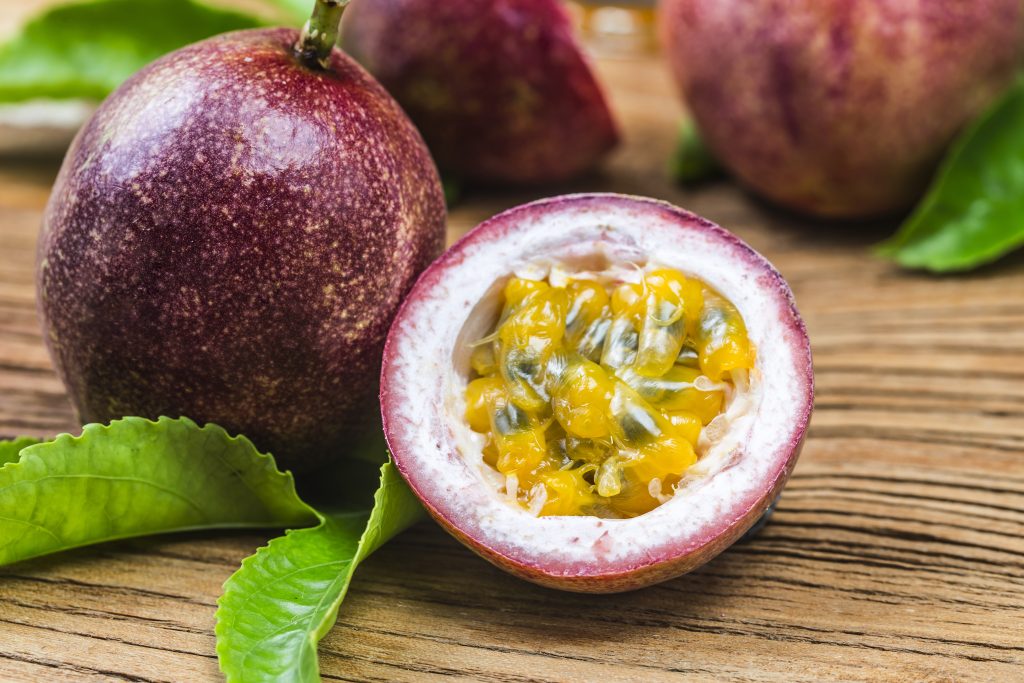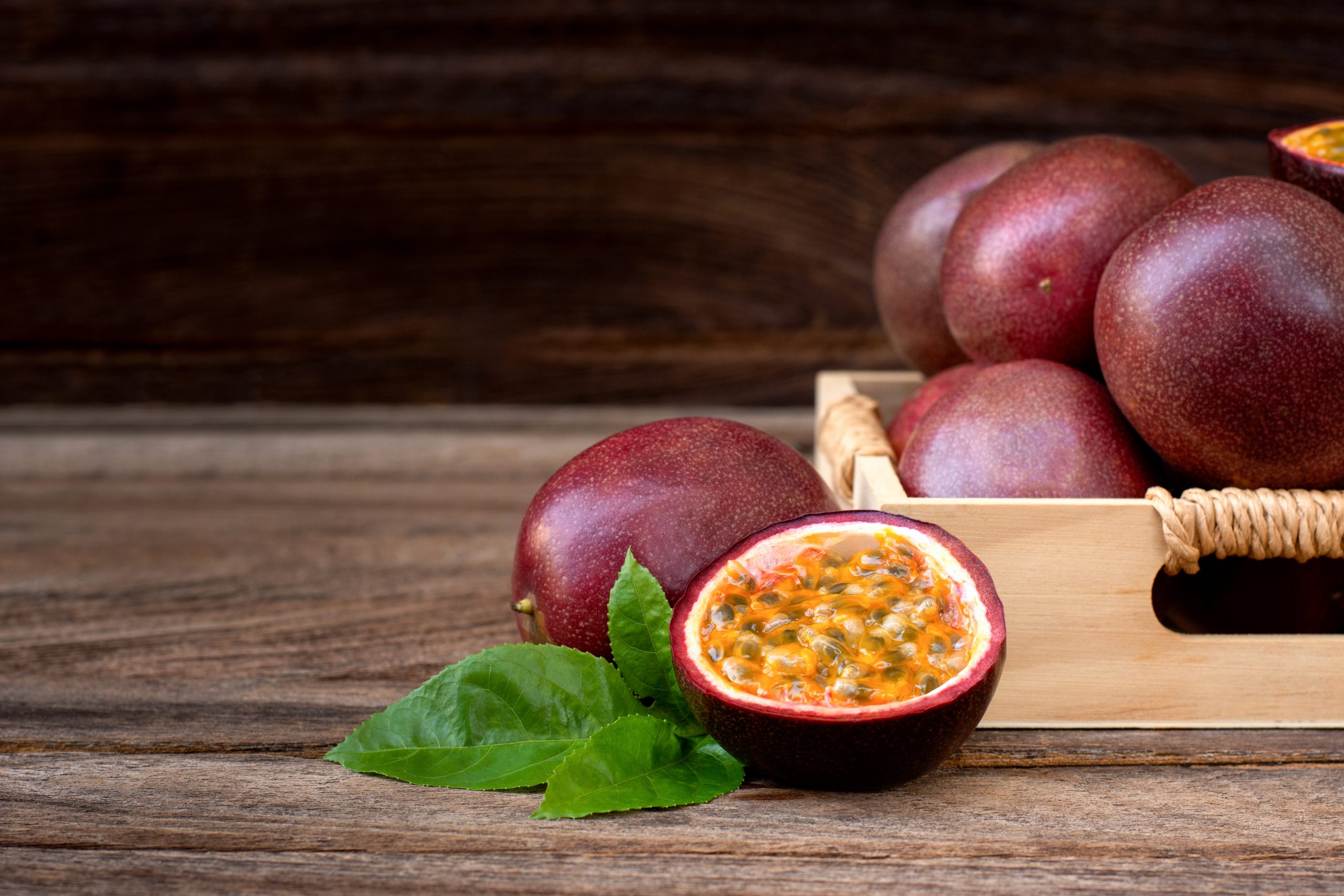Passion fruit is a tropical fruit from South America with notes of kiwi and mangoes with a tart, citrusy sweetness. The passion fruit's unusual juicy pulp with large, edible seeds makes it incredibly unique.
Table of Contents
What is a Passion Fruit?
Passion fruit (Passiflora edulis) is a bright red tropical fruit that grows on passion fruit vines, similar to grapes.
It earns its name, passion fruit, because it comes from the passion flower, and there are around eight different types of passion fruit. Other varieties of passion fruit include purple passion fruit, yellow passion fruit, giant passion fruit, Maracuya, and Granadilla.
Passion fruit has a royal purple or red rind that hides a juicy pulp with crunchy edible seeds. The passion fruit flavors are incredibly tropical, with sweet notes of kiwi, pomelos, and mangoes with an acidic kick of citrus flavors. As the fruit ripens, the sour notes fade into a robust sweetness.
The History of Passion Fruit
Passion fruit was first discovered in subtropical regions in South America in places like Brazil, Northern Argentina, and Paraguay.
It wasn’t until later in the 1800s that the seeds of this tropical flowering vine were sent to similar tropical areas like Hawaii, Florida, New Zealand, Australia, and other portions of South America.
Today, Peru is the leading exporter of passion fruit worldwide.

What Does a Passion Fruit Taste Like?
When you cut into the leathery rind of fresh passion fruit, you are met with a beautiful fruity aroma similar to peaches, strawberries, or berries. Some even describe the fragrance as a fruit punch!
The flavors inside are sour and sweet, with the juicy pulp having a pineapple-like bite and a sharp citrus punch. The black seeds inside are edible and offer a bright crispy crunch with the texture of something deep-fried.
Most prefer to eat passion fruit raw or blended into passion fruit juice, smoothies, tea, or cocktails. When baked into desserts, the sour notes fade away, and the sweetness of the fruit shines through.
How to Tell When Passion Fruit is Ripe
It’s super easy to tell when a passion fruit is ripe by following these easy steps.
| Color | Ripe passion fruit has an incredibly deep maroon or royal purple coloring. If the passion fruit is still green, it’s unripe. If it’s a yellow variety, look for yellow skins. |
| Firmness | The rind will be stiff but will have a slight give when you press into it. If the skin is a little wrinkly, that’s ok! It means it’s perfectly ripe, sweet, and ready to eat. |
| Smell | When ripe, the outside of the passion fruit should smell bright and fragrant with a hint of floral notes. If you can’t smell anything on the outside, it means it’s not ripe. |
| Bruising | It’s normal for passion fruit to become bruised, which means it’s too ripe. Overly ripe passion fruit is safe and may be more sweet than sour. |
| Cracks | While bruising and wrinkling are normal, avoid passion fruit with cracks or cuts on the outside of its skin. Passion fruit with gaps in their skin is prone to become moldy inside. |
Cooking with Passion Fruit
Before cooking with passion fruit, you must know how to prepare it properly. Luckily, preparing passion fruit for baked treats and cocktails is simple.
1. Wash the outside. Even though you don’t eat the outside, it’s always a good idea to run the rind over cool water and wipe it down with a dishcloth to remove debris.
2. Cut the passion fruit in half. The outer skin of passion fruit is tough, like leather. Use a sharp kitchen knife to penetrate the rind and slice it in half.
3. Remove the passion fruit pulp and seeds. Using a spoon, scoop out the yellow pulp surrounding the passion fruit seeds. While the white rind is technically edible, it’s a little bitter. When cooking, leave the white pith behind.

We recommend the following passion fruit recipes:
Passion Fruit Ice Cream: One of the best ways to celebrate the tropical flavors of passion fruit is with this passion fruit ice cream. As a take on the classic Brazillian dessert passion fruit mousse, it’s light, creamy, and bursting with tart tropical flavors.
Passion Fruit Puree: This passion fruit puree is a must-try for a topping on cheesecake or toast. It only takes 10 minutes to make and is excellent in fresh summertime cocktails. And for a light, savory dinner, these Vietnamese spring rolls with peanut and passion fruit sauce explode with tropical and spicy flavors.
How to Store Passion Fruit
Surprisingly, passion fruit has a long shelf life, even when stored at room temperature. Passion fruits left out on the counter will stay fresh for up to two weeks.
To extend their life further, place them in a bag and pop them in the vegetable crisper in your refrigerator. Passion fruit stored in the fridge will stay fresh for about 30 days.
Passion fruit is also a good candidate for freezing. You can place whole passion fruit in the freezer and defrost it overnight in the fridge.
For easy smoothies, scoop out the insides of your passion fruit and portion it into ice cube trays. Frozen passion fruit stays fresh for about three months.
Nutritional Benefits of Passion Fruit
Passion fruit is a nutritional powerhouse. It’s low in calories (about 17 calories per passion fruit), high in vitamins, minerals, phosphorus, and polyphenols, and low in cholesterol. One passion fruit may have a higher daily value of Vitamin C than an orange!
Vitamin C helps keep your immune system strong, lowers inflammation, and fights heart disease and cancer. These positive health effects skyrocket when combined with a high concentration of polyphenols.
And even though it’s small, one serving of passion fruit provides a good serving of fiber. Fiber helps promote good gut health and nutrition and makes you feel full.
Where to Purchase Passion Fruit
Passion fruit may be tropical and grows in warm climates, but it’s widely available at most supermarkets. Often, it’s located in the tropical fruit section of your local grocery store year-round.
If you can’t find it at your local supermarket, it will likely appear at farmer’s markets or specialty fruit stands. While it’s available year-round, you can track it down when it’s at its peak in August to November or February to June.

